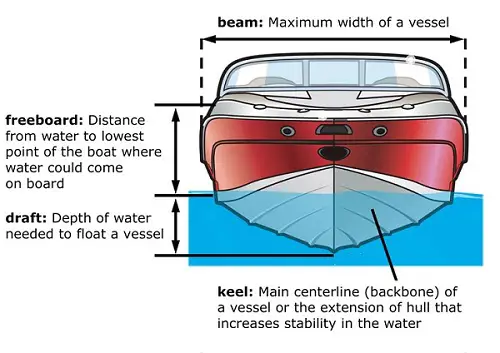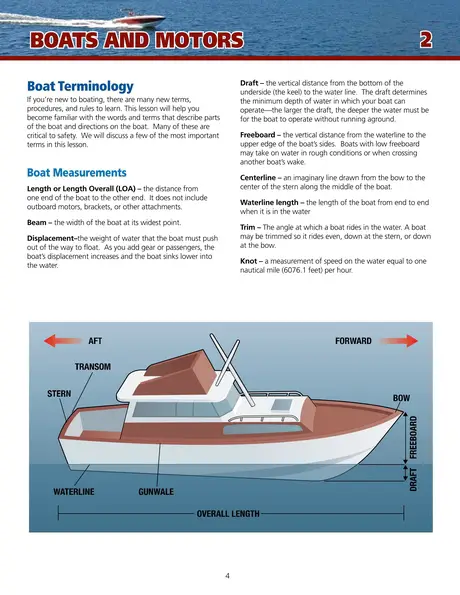Freeboard is a ship’s/boat’s measurement from the waterline to the upper edge of deck plating at the side, and it’s important for safety. If you don’t have enough freeboard, your boat may not be safe to sail in certain situations or conditions.
Freeboards are measured in inches or centimeters, depending on what country you live in. They are usually included in a boat or yacht’s specifications.

Understanding the basics of freeboard is important for any boat owner. Vessels are required by law to have load line marks that indicate their maximum allowable draught under specified conditions (geographical and seasonal).
It’s also worth knowing what draft means so you can compare it with your own measurements. The draft is simply how far below the waterline an object sits when in waters.
Why Would Someone Need to Know the Boat Freeboard?
Freeboard is extremely important because it protects the boat’s structure and its contents. If your freeboard is too low, waves or swells could easily capsize or swamp your boat when out at sea. This would be very dangerous for passengers and crew, not to mention costly to repair.
On the other hand, if your freeboard is too high, this could also be dangerous, especially if the boat is loaded with cargo or passengers. It could also affect the dynamic performance of the boat and create resistance in the water that uses up valuable power from its engine.
The consequences of low freeboard: You wouldn’t want your boat to sink or become less maneuverable, so it’s important you understand what the consequences of low freeboard are. If your boat doesn’t have enough freeboard, heavy waves or wind could fill it with water and sink the vessel. This is a serious problem because it could risk lives or severely damage the vessel.
Low freeboard also means that although the boat has enough space to take on passengers or cargo, it could lose stability when the vessel becomes flooded.
Why Does It Matter How High the Freeboard Is?
The height of a vessel’s freeboard is important because it ensures the boat can ride over rough seas and survive waves without sinking. If your boat has a low freeboard, it may have trouble with waves that are too high for it to handle safely.
And, too high is just as bad, because it can create undesirable resistance in the water. It requires a lot of power to simply push the vessel through the water when it has too much freeboard. Generally, this means more fuel is used and your boat would never go as fast or be able to travel the same distance in the same amount of time.
Since freeboard is essential for your boat, ensure that it always has enough of it to be safe.
What Is a Safe Freeboard?
The best way to determine the correct freeboard for your boat is on a vessel’s load line certificate. Safe freeboard is the minimum distance between your boat’s uppermost deck and the waterline, which you can use to prevent it from sinking after extreme weather.
Safe freeboard is determined by the weight of your boat when empty, fully loaded but still afloat, with maximum crew/passenger capacity. What this means is that your boat always has to have more space for cargo or people than what you are carrying at that moment.
It depends on the vessel’s size and load capacity. Once you know the load capacity of your vessel, you can adjust the waterline to make sure it has enough freeboard and stability.
How to Check Your Boat’s Freeboard Level?
The load line mark should always be visible on your boat, even if it’s covered with water. You can use a measuring tape to see how high your vessel is above the surface of the water. To measure the distance between the uppermost deck and waterline, go from bow to stern and take a reading at both ends of the boat.
What Is the Difference Between Draught and Freeboard?
The draft is how deep an object sits in the water. It’s easy to confuse this with freeboard, but they are completely different.
Draught refers to the depth of an object like a boat below the waterline, while freeboard refers to the height of the boat’s uppermost deck.
Boat’s depth = Draught + Freeboard
So, Freeboard = Depth – Draught

Is High Freeboard Good?
When it comes to boating, “freeboard” refers to the distance between the waterline and the deck of the vessel. A boat with a high freeboard has more distance between the water and the deck, while a boat with a low freeboard has less distance. So, is high freeboard good?
It depends on what you’re looking for in a boat. If you’re concerned about keeping your passengers dry, then a high freeboard is definitely advantageous. Boats with high freeboards are less likely to take on water in rough conditions, and they also offer more protection from waves and spray.
However, if you’re looking for a boat that’s easy to get in and out of the water, then a low freeboard might be better suited for your needs.
What is the Purpose of Freeboard?
The purpose of freeboard is to provide a safe and stable voyage for people.
Freeboard is the height from the waterline to the top of a ship’s deck at the side. It determines how much of a ship will be above the waves in different sea states. The freeboard affects not only how high a wave will wash on deck but also how stable a vessel will be in various weather and sea conditions.
A higher freeboard means that more of the ship is above water and thus less likely to capsize or founder. Freeboard is measured from the deck line amidships to the top of the gunwale (the upper edge of a vessel’s sides). It is important to calculate freeboard accurately because it directly affects a vessel’s safety.
In order to do so, one must first determine the ship’s draft (the vertical distance between the waterline and the bottom of the hull).
Conclusion
When you’re out on the open water, one of the most important things to consider is freeboard. It’s important to have enough freeboard to keep your boat stable and dry in rough conditions.
If you don’t have enough freeboard, your boat could be swamped by waves or take on water if it capsizes. So how much freeboard do you need? That depends on the type of boat you have and how it will be used.
For example, a small rowboat used for fishing in calm waters doesn’t need as much freeboard as a large yacht used for sailing in rough seas. The bottom line is that you should talk to an expert about what kind of freeboard is right for your boat.
